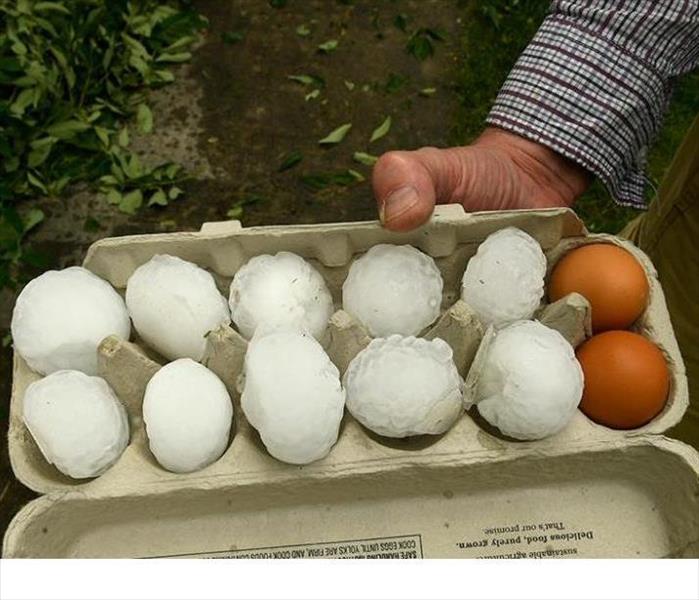Hail Causes the Most Storm Damage Costs Across North America
3/20/2019 (Permalink)
The icy weather phenomenon leads to more than $10 billion in damages each year. Nonetheless, research on hail is lacking, scientists say. By Ilima Loomis On 18 June, Katy Human and her family watched as tiny chunks of ice fell from the sky. At first, Human and her family, of Louisville, Colo., were delighted. “Hail is cool and relatively rare, so we all went out on the front porch to watch it,” she said. However, “Over the next 10 minutes, it got bigger and bigger.” The family backed up, pressing against the wall of their house as golf- and tennis-ball-sized hailstones pummeled their yard. “We have a garage, but both cars were out,” she said. “It went from ‘Oh, my God, isn’t this beautiful’ to ‘Holy crap, this is doing a lot of damage.’” Human’s family was witness to something that people in the insurance industry have long known. Tornadoes and hurricanes may grab headlines, but when it comes to property damage, the biggest extreme weather culprit is an often overlooked weather phenomenon: hail. Hailstorm destruction exceeds $10 billion each year across North America, accounting for almost 70% of the property damage in insurance claims from severe storms, said Ian Giammanco, lead research meteorologist at the Insurance Institute for Business and Home Safety’s research center in Richburg, S.C. But, he said, funding for hail studies is limited, and the phenomenon is often treated by the public as a curiosity. Giammanco spoke Tuesday on a panel of scientists at the North American Workshop on Hail & Hailstorms. The 3-day symposium, the first of its kind in the United States, was hosted by the National Center for Atmospheric Research (NCAR) in Boulder, Colo. The workshop occurred just a week after a severe hailstorm pelted Colorado Springs, about an hour’s drive from Boulder, with hailstones reported to be as large as softballs. The storm caused millions of dollars in property damage, injured more than a dozen people, and killed five animals in the Cheyenne Mountain Zoo. Colorado and the central United States are hot spots for hailstorms, explained panelist Andreas Prein, an NCAR project scientist expert on climate modeling with a focus on severe storms. Colloquially called “hail alley,” the area has the right conditions for severe thunderstorms that can produce large hailstones. A severe hailstorm needs unstable air with a strong updraft, differing wind speeds and wind directions, air that’s humid close to the ground and dry at higher altitudes, and a freezing point that’s relatively close to the ground. These conditions work together to form the largest hailstones, by drawing moisture up from the ground and quickly cooling it into hailstones; circulating those hailstones around and around within the storm, allowing them to pick up moisture and grow larger; and giving them a short distance to fall back to Earth, so they don’t melt on the way down, Prein said. But humans are also thought to be influencing hail itself, through climate change. The effect, however, isn’t straightforward, influencing hail-forming conditions in varied and sometimes contradictory ways, Prein explained. For example, climate change is expected to increase air buoyancy for strong updrafts, but at the same time it appears to be causing the freezing level to move higher above the ground. “The question is, How are these things interacting, and how are they affecting hail frequency?” Prein said. He noted that whereas most of the country has seen hail decrease over the past 100 years, certain areas, including the central United States and the mid-Atlantic states, have seen it become more frequent and severe. “We need more research on that to really understand how climate change and climate variability [are] changing hail hazard,” Prein said. Hail expert and panelist Andrew Heymsfield, NCAR senior scientist and cochairman of the workshop, noted that a hailstorm-penetrating aircraft that had been used to gather important data since the 1970s was decommissioned in 2003, leaving scientists without an important tool for research for the past 15 years. Another panelist, Kristen Rasmussen, an atmospheric scientist at Colorado State University in Fort Collins, hopes to help reset the scales. She travels to Argentina later this year to study one of the most hail-prone areas in the world. For her field project, funded by the National Science Foundation and the U.S. Department of Energy, Rasmussen plans to bring a suite of ground-based radars, hydrological gauges, lightning mapping instruments, and other equipment to learn more about the science of severe storms and hail formation. “We’re trying to study the whole convective process from beginning to end,” she said. For Human, who works with storm researchers as communications director for the Cooperative Institute for Research in Environmental Sciences at the University of Colorado Boulder, the science of hail is now personal. Still, Human didn’t lose her sense of wonder for hail. “They’re beautiful when they crack open,” she said. “There are these intricately layered concentric circles, like tree rings. They’re gorgeous.” Want more information of Storm Damage. Call SERVPRO of Henderson/Boulder City today at: 702-564-8508Making Hail
Climate Effects Unclear
Hail damage is expected to increase in coming years, largely driven by population growth and suburban sprawl. Sprawl means more buildings, and thus “bigger targets for hailstorms to hit,” Giammanco said.Efforts to Study Hail
Extensive Damage

 24/7 Emergency Service
24/7 Emergency Service
